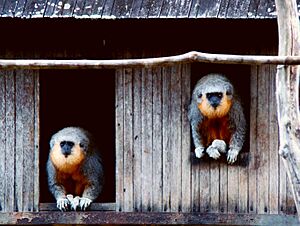Red-bellied titi monkey facts for kids
Quick facts for kids Red-bellied titi |
|
|---|---|
 |
|
| Conservation status | |
| Scientific classification | |
| Genus: |
Plecturocebus
|
| Species: |
moloch
|
 |
|
| Red-bellied titi range | |
| Synonyms | |
|
Callicebus moloch Hoffmannsegg, 1807 |
|
The red-bellied titi monkey (Plecturocebus moloch) is a small, furry monkey. It is also sometimes called the dusky titi. These monkeys are a type of New World monkey, which means they live in the Americas. You can only find them in Brazil, where they live in thick forests and bushy areas.
Red-bellied titis have a round head and a soft, thick coat of fur. They often sit in a special way, with their body hunched and their arms and legs close together. Their long tail usually hangs down. Their body is about 28 to 39 centimeters (11 to 15 inches) long. Their tail is even longer, measuring about 33 to 49 centimeters (13 to 19 inches).
These monkeys can move quickly when they need to. However, they usually stay in a small area. They eat fruits, insects, spiders, small birds, and bird's eggs. Red-bellied titis are active during the day. They live in pairs or small family groups. They use many different sounds to talk to each other. Female titi monkeys usually give birth to one baby at a time.
Contents
What Does a Red-Bellied Titi Look Like?
Red-bellied titi monkeys are about the same size for both males and females. Their head and body are usually around 33 centimeters (13 inches) long. Their tail is longer than their body. Males weigh between 850 and 1200 grams (1.9 to 2.6 pounds). Females are a bit lighter, weighing from 700 to 1020 grams (1.5 to 2.2 pounds).
Hands, Feet, and Teeth
These monkeys have a larger thumb than their big toe. They have six special pads on their palms. Each of their five fingers and toes has a nail. They have 36 teeth in total. Their upper front teeth (incisors) are long. Their canine teeth are small and barely stick out past their other teeth. Their ears are quite large but are often hidden by the fur on the sides of their head. Their nose has a wide middle part, and their nostrils open to the sides.
Fur Color
Adult red-bellied titis can have grey, reddish, or brown fur on their back. They usually have white or black stripes on their forehead. This fur pattern is the same for both young and adult monkeys.
How Do Red-Bellied Titis Behave?
Red-bellied titi groups usually have two to four monkeys. This often includes an adult female and an adult male. Young monkeys tend to leave their family group when they are about 2 to 3 years old. These monkeys rarely interact with other types of primates.
Family Life and Bonding
The bond between a male and female titi monkey pair is very strong. Once they form a pair, they stay very close to each other. They often intertwine their tails whenever they can. Couples tend to follow each other and stay near each other all day. Male titis play a big role in taking care of the babies. Older brothers and sisters usually do not help raise the young.
Adult titis use a special signal called "chest rubbing." They slowly drag branches along their chest. After rubbing, they might smell or rub the area again. This might be a way to mark their territory or communicate.
Habitat and Diet
Red-bellied titis prefer to live in lower, denser tropical forests. They especially like areas near rivers and river banks. They mostly eat fruit, but their diet also includes twigs, leaves, and insects. They have a fairly small home area. Like other titi monkeys, they are very protective of their territory. They use loud calls to mark their area and scare away other animals.
Grooming and Social Contact
Grooming happens often throughout the day, especially when the monkeys are resting. Both females and males, adults and young, take part in grooming. It is thought that grooming helps them get used to each other's presence and physical contact. Adults and young monkeys also intertwine their tails with monkeys of the opposite sex when they are close to each other within their social group.
Communication and Signals
Red-bellied titis use many different body postures and facial expressions to communicate. For example, they might sway their whole body, turn their head sideways, or lower their head to face downward. These signals are often used when they are disturbed or want to escape.
If a red-bellied titi arches its back, it is a warning that they might attack. This signal is linked to being hostile. After they arch their backs, an attack usually follows. Other hostile signals include making their fur stand up (piloerection) and lashing their tail. These often happen after back arching and are used to scare others away.
Their facial expressions include partly or fully closing their eyes, sticking out their lips, and showing their teeth. Showing teeth is usually followed by smacking their lips.
Parental Care and Reproduction
Male red-bellied titis are usually the ones who carry and take care of the babies. Females only lick and nurse the infants. Adult males are responsible for carrying the babies, except when the baby is being nursed or licked by the mother. Sometimes, a young monkey will move from one adult to another, especially when the two adults are close. There is a strong bond between males and young monkeys once the young can move around on their own.
Images for kids




